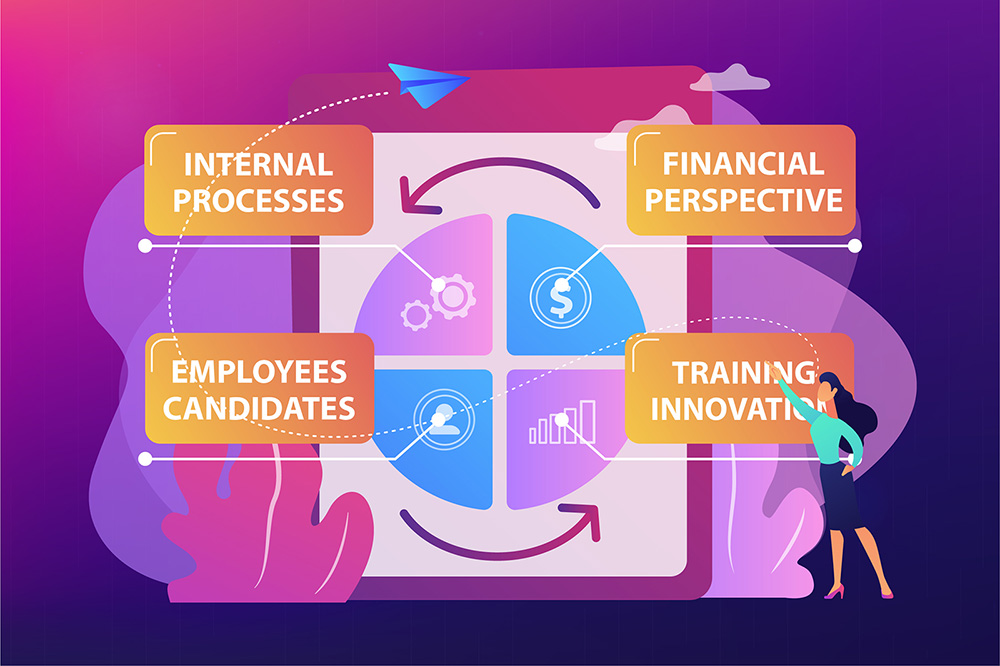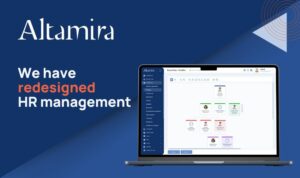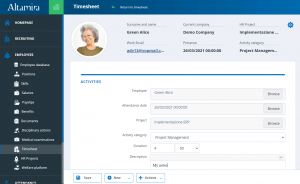In recent years, HR managers have begun to make greater use of data and metrics in their work.
This change has been made possible both by the adoption of digital tools—most importantly, HRM software—that are able to track data and produce KPIs (Key Performance Indicators), and by a change in mentality that is pushing the Human Resources department to take up an increasingly strategic role in the company.
In this article, we present a way of organizing KPIs borrowed from the marketing and management areas that will allow you to get a complete view of the progress of the company’s HR processes with just a few indicators.
This method, called the “balanced scorecard”, organizes the metrics into four quadrants:
- The financial perspective
- The perspective of employees and/or candidates
- The perspective of the company’s internal processes
- The perspective of training and innovation
For each quadrant, you must identify a minimum of 1 up to a maximum of 3 metrics that are particularly relevant for the company. Tracking a small number of metrics is essential even for large companies. Correctly maintaining a large number of KPIs is difficult and expensive, and having too many numbers risks making the resulting conclusions more confused instead of clarifying them. In short, it’s better to have just a few, but the right ones.

The advantage of this method is that it allows immediate feedback on the effects that an initiative is having on different areas. What impact does an increase in salaries have on the turnover rate? Does increased participation in training courses increase employee performance? Does investing more in sponsored job ads reduce the employee search and selection time?
The balanced scorecard is not just a mere measuring instrument. For each KPI tracked, one must decide on a target to be achieved and the actions to be taken to achieve it.
The objectives should be set in accordance with the SMART principle (Specific, Measurable, Attainable, Relevant and Time-bound). Thus, a SMART objective could be to achieve a staff turnover rate of 9% within 3 years, starting from a value of 11% and including intermediate objectives.
Examples of HR metrics for the balanced scorecard
There are very many KPIs that can be used for each quadrant, and each company should choose its own indicators according to the importance they have for its processes and its ability to track them in a timely manner.
Here are some examples.
HR KPIs for the financial perspective
Financial KPIs may refer to personnel management or recruitment activities.
- Average cost of labor. Knowing the average cost of an employee in the company, including gross annual salary, social security and insurance contributions and the severance indemnity fund, is fundamental for prudent business management. By comparing this data with the salaries offered by competitors, one can get a clear picture of the competitiveness of the company’s wages.
- Percentage of labor costs. This KPI measures the proportion of personnel costs out of total business costs. How much is the company investing in people?
- Cost of training per employee. How much does the company invest, on average, in the training of an employee?
- Cost per hire. This metric measures the cost incurred for each hire. It is not an easy metric to calculate, and this process can be approached in several ways. For example, by choosing to track only sponsored ads and media expenses, only external service expenses, or all expenses, internal and external.
HR KPIs for the perspective of employees and candidates
Are employees and candidates satisfied with the company climate and the application process? To answer this question, you can adopt quantitative KPIs (such as turnover rate or offer acceptance rate) or qualitative KPIs (the outcome of surveys). The best solution is probably a mix of the two.
- Turnover rate. The overall turnover rate is calculated using a well-known formula: ((No. of employees hired during the year + No. of employees who left during the year)/average annual staff) * 100. It makes sense to consider it together with the voluntary turnover rate, which tracks only the people who left the company at their own initiative.
- Absenteeism rate. Another indicator that is useful for understanding the level of involvement of the workforce is the absenteeism rate. It is calculated by dividing the number of days of absence by the total number of work days at the company and multiplying by 100. It can also be calculated in hours.
- Survey on the level of employee satisfaction. The best way to calculate the employee satisfaction rate is to have them fill out an anonymous survey. One of the most used KPIs is the Net Promoter Score. This is obtained by asking employees how likely is it that they would recommend the company as a workplace, on a scale from 1 to 10. The Net Promoter Score is calculated by subtracting the percentage of detractors (who answered from 0 to 6) from the percentage of promoters (who answered 9 or 10, while those who answered 7 or 8 are considered neutral). The result is expressed as an absolute number between -100 and +100.
- Survey on the level of employee satisfaction regarding benefits. Are the benefits provided by the company appreciated by the employees? Because of the effect these have on retention and attraction, it’s important to measure this from time to time through a survey.
- Sentiment Analysis. Thanks to the reviews on portals such as Indeed and Glassdoor, today it is possible to know and track the prevailing opinion of employees and former employees towards the company.
- Offer acceptance rate. The offer acceptance rate by candidates is a good quantitative indicator of the effectiveness of the selection process.
- Survey on the level of candidate satisfaction. Surveying candidates on the quality of the application process serves to improve the recruiting and employer branding strategy.
HR KPIs for the perspective of internal company processes
These metrics serve for getting an understanding of how efficient the human resource management processes are. By improving their performance, it is possible to get immediate returns on other quadrants as well.
- Onboarding. To determine the efficiency of your onboarding plan, you can monitor numerical data (e.g. how many days it takes the new employee to complete the routine of joining the company) or use a satisfaction survey. It has been shown that a good onboarding process has a great impact on staff retention.
- Rate of completion of the evaluation processes. Are the performance management processes being completed? How quickly, and with what success rate?
- Internal promotion rate. This is calculated by dividing the number of people promoted internally by the total number of employees, and it is a useful indicator of retention capacity.
- Percentage of referrals. This KPI indicates how many positions in the company are covered by candidates referred by employees. A high percentage will lead both to a reduction in search and selection costs and to a high level of employee satisfaction, who are obviously happy to recommend the company as a place to work.
- Time to Fill. This metric calculates how long it takes us to get a new employee into the company, from the beginning of the candidate search until hiring. Shortening the time to fill reduces selection costs and increases candidate satisfaction.
Other useful KPIs concern the management of diversity and of the gender gap in the company.
HR KPIs for the perspective of training and innovation
- Course attendance rate. Calculating a true ROI for training is not easy, but we should at least track how actively the employees are taking part in the company training courses.
- Effectiveness of training. The effectiveness of the training can be tracked through employee surveys. In this way, we will make sure that the courses offered have been helpful in improving their productivity.
- Skills gap. This is an essential KPI in order to calculate the gap between the actual skills of the staff and the level they should reach in order to better fulfill their role.
- Rate of adoption of IT tools. In the areas where you have undertaken a project for the digitization of human resources management, it is advisable to monitor the situation to make sure that the new tools are being used by the HR department, the managers and the employees.
Copyright: ©fizkes/Adobe Stock




























































































